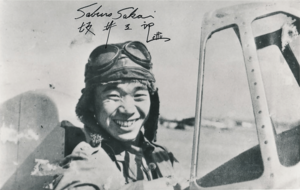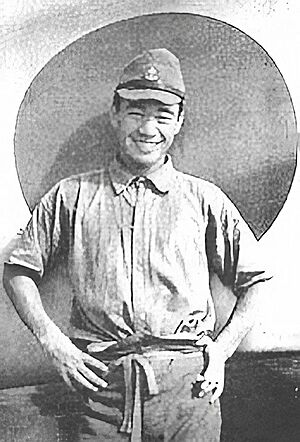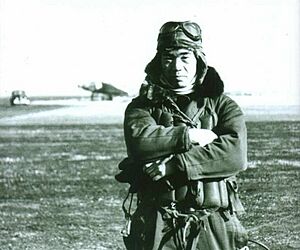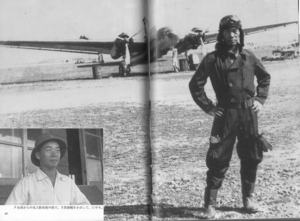Saburō Sakai facts for kids
Quick facts for kids
Saburō Sakai
|
|
|---|---|

Sakai in the cockpit of a Mitsubishi A5M Type 96 fighter (Hankow airfield, China in 1939)
|
|
| Native name |
坂井 三郎
|
| Nickname(s) | Sky Samurai |
| Born | 25 August 1916 Saga, Japan |
| Died | 22 September 2000 (aged 84) Atsugi Naval Air Station, Kanagawa Prefecture, Japan |
| Allegiance | |
| Service/ |
|
| Years of service | 1933–45 |
| Rank | |
| Unit | Tainan Naval Air Wing Yokosuka Naval Air Wing 343rd Naval Air Group |
| Battles/wars | Second Sino-Japanese War
|
| Spouse(s) | Hatsuyo (1944-1947) Haru (1952-2000) |
| Children | 3 |
Saburō Sakai (坂井 三郎, Sakai Saburō, 25 August 1916 – 22 September 2000) was a famous Japanese naval pilot during World War II. He was known as a "flying ace," which means he shot down many enemy aircraft. Official Japanese records say he had between 28 and 64 victories. His book, Samurai!, claims he shot down 64 planes.
Contents
Saburō Sakai was born in Saga Prefecture, Japan, on August 25, 1916. His family had a history linked to the samurai, who were ancient Japanese warriors. However, his family later became farmers.
Sakai was the third of four sons and had three sisters. When he was 11, his father passed away. His mother had to raise seven children alone. Sakai's uncle helped him by paying for his education at a high school in Tokyo. But Sakai did not do well in school and returned home after two years.
On May 31, 1933, at age 16, Sakai joined the Imperial Japanese Navy as a new sailor. He trained at the Sasebo Naval Base.

After his training, he served on the battleship Kirishima. In 1935, he passed tough exams to join the Naval Gunners' School. He was promoted several times.
In early 1937, he was accepted into the navy pilot training program. He finished first in his class in 1937 and received a special silver watch from Emperor Hirohito. Sakai became a pilot trained for aircraft carriers, but he never actually served on one.
In 1938, Sakai was promoted again. He flew the Mitsubishi A5M fighter in battles during the Second Sino-Japanese War. He was injured during this time. Later, he was chosen to fly the newer Mitsubishi A6M2 Zero fighter in China.
World War II Combat
Fighting in Southeast Asia
When Japan began attacking the Western Allies in 1941, Sakai was part of the Tainan Air Group. He took part in the attack on the Philippines. On December 8, 1941, Sakai flew one of 45 Zero planes that attacked Clark Air Base in the Philippines. In his first fight against Americans, he shot down a Curtiss P-40 Warhawk. He also destroyed two large B-17 Flying Fortresses by shooting at them on the ground.
The next day, Sakai flew missions in bad weather. On the third day of the battle, Sakai claimed to have shot down a B-17 bomber flown by Captain Colin P. Kelly. Sakai was a leader in this fight, but he and his two wingmen were not officially given credit for this victory.
In early 1942, Sakai moved to Tarakan Island in Borneo and fought in the Dutch East Indies. Japanese commanders told pilots to shoot down all enemy planes, even if they were unarmed. One day, Sakai was flying his Zero over Java. After shooting down an enemy plane, he saw a civilian Dutch Douglas DC-3 flying low over the jungle.
Sakai first thought it was carrying important people. He signaled for the pilot to follow him, but the pilot did not obey. Sakai flew closer to the DC-3. He saw a woman and a young child through a window, along with other passengers. The woman reminded him of a kind American teacher he had in middle school. He decided to ignore his orders. He flew ahead of the DC-3 and signaled for the pilot to continue on his way. The pilot and passengers saluted him. Sakai did not mention this event in his official report.
During the Borneo Campaign, Sakai achieved 13 more victories. He then became ill and was grounded. After he recovered in April, he joined a squadron of the Tainan Air Group in Lae, New Guinea. Over the next four months, he shot down many planes while fighting American and Australian pilots based at Port Moresby.
There is a famous story about Sakai and his fellow aces, Hiroyoshi Nishizawa and Toshio Ota. It is said that on May 16, they listened to an Australian radio program playing the spooky "Danse Macabre" music. Nishizawa supposedly suggested they do loops over the enemy airfield. The next day, after an attack on Port Moresby, the three pilots performed three tight loops over the Allied air base. They did three more loops without being shot at. The next day, an Allied bomber dropped a note saying, "Thank you for the wonderful display... we will have a warm reception ready for them, next time." Their commander was very angry, but the pilots felt it was worth it. However, this story is now believed to be made up by Martin Caidin, who helped Sakai write his book.
Battles in the Pacific
On August 3, 1942, Sakai's air group moved to Rabaul. On August 7, they learned that US Marines had landed on Guadalcanal. The Marines captured an airfield, which they named Henderson Field. This airfield became very important in the Guadalcanal Campaign. It allowed US planes to stop the Japanese from bringing supplies to their troops. This led to almost daily air battles for Sakai's group.
US Marines flying Grumman F4F Wildcat planes from Henderson Field used a new fighting trick called the "Thach Weave." This tactic confused the Japanese Zero pilots at first.
On August 7, Sakai and three other pilots shot down an F4F Wildcat flown by James "Pug" Southerland. Southerland later became an ace himself. Sakai and Southerland had a long and skillful dogfight. Sakai finally shot down Southerland's Wildcat. Southerland parachuted to safety.
Soon after, Sakai was attacked by a single Douglas SBD Dauntless dive bomber. It was flown by Lieutenant Dudley Adams. Adams almost hit Sakai's plane and sent a bullet through his cockpit window. But Sakai quickly gained control and shot down Adams's plane. Sakai said this was his 60th victory.
Serious Injuries
After shooting down Southerland and Adams, Sakai saw eight planes flying near Tulagi. He thought they were more Wildcats and tried to surprise them. However, he soon realized his mistake. These planes were actually carrier-based bombers with machine guns in the back. He was too close to turn back, so he had to continue his attack.
Sakai said these planes were Grumman TBF Avengers. He claimed to have shot down two of them (his 61st and 62nd victories) before their return fire hit his plane. Other Zero pilots seemed to confirm these kills, but no Avengers were reported lost that day by the US Navy.
According to US Navy records, only one group of bombers reported fighting Zeros in similar conditions. These were eight SBD Dauntlesses from the Enterprise. Their rear gunners claimed to have shot down a Zero that flew directly behind them.
Whatever happened, Sakai was badly hurt by the bombers' gunfire. A bullet hit his head, damaging his skull and temporarily making the left side of his body unable to move. The bullet also shattered his goggles and blinded him in his right eye. His left eye's vision was also very poor. His Zero plane flipped upside down and started falling toward the sea.
Sakai could not see well because of the glass and blood. But as tears cleared his eyes, he slowly regained some vision. He pulled his plane out of the dive. He thought about crashing into an American warship, wanting to die like a samurai. But then the cold air in the cockpit helped him think clearly. He decided to try and fly back to his base in Rabaul.
Even with his severe injuries, Sakai managed to fly his damaged Zero for 4 hours and 47 minutes. He flew over 560 nmi (1,037 km) back to Rabaul, using volcanoes as guides. When he tried to land, he almost crashed into other planes. After circling four times with an empty fuel tank, he landed his Zero on his second try. After landing, he insisted on giving his mission report to his officer before he collapsed. He was then taken to a surgeon. Sakai was sent to Japan on August 12 for a long and difficult surgery. The surgery fixed some of the damage to his head, but he never fully regained vision in his right eye.
Recovery and Return to Duty
After leaving the hospital in January 1943, Sakai spent a year training new fighter pilots. He found that the new pilots were often arrogant and not very skilled. Japan was clearly losing the air war, so Sakai asked his commanders to let him fly in combat again. In November 1943, Sakai was promoted to warrant officer. In April 1944, he was moved to the Yokosuka Air Wing, which was stationed at Iwo Jima.
On June 24, 1944, Sakai approached 15 US Navy Grumman F6F Hellcat fighters. He mistakenly thought they were friendly Japanese planes. Despite facing stronger enemy aircraft, Sakai used his skill to avoid their attacks and returned to his airfield safely.
Sakai said he never lost a wingman in combat, but he did lose at least two over Iwo Jima.
Sakai stated he was ordered to lead a kamikaze mission on July 5, but he could not find the US fleet. He was attacked by Hellcat fighters, and almost all the Nakajima B6N2 "Jill" torpedo bombers in his group were shot down. Sakai managed to shoot down one Hellcat and escaped by flying into a cloud. Instead of following orders in bad weather, Sakai led his small group back to Iwo Jima. However, his official report said his mission was to escort bombers, and he joined an attack on the US fleet on June 24.
In August 1944, Sakai became an ensign. He was transferred to the 343rd Air Group and then returned to the Yokosuka Air Wing. Around this time, Sakai married his cousin Hatsuyo.
Saburō Sakai took part in the last mission of the Imperial Japanese Navy Air Service. On August 18, he attacked two Consolidated B-32 Dominator planes. These planes were taking photos and checking if Japan was following the ceasefire. Sakai first thought they were Boeing B-29 Superfortresses. Both US planes returned safely to their base. This final encounter was not included in Sakai's book, Samurai!.
After the war ended, Sakai was promoted to sub-lieutenant.
Life After the War
After the war, Sakai left the Navy. He became a Buddhist and promised never to kill any living thing again, not even a mosquito.
Even though Japan lost World War II with many lives lost, Sakai calmly accepted the outcome. He said, "If I had been ordered to bomb Seattle or Los Angeles to end the war, I wouldn't have hesitated. So I perfectly understand why the Americans bombed Nagasaki and Hiroshima."
Life was hard for Sakai after the war. He struggled to find a job, and his first wife, Hatsuyo, passed away in 1947. He remarried in 1952 and started a printing business.
Sakai sent his daughter to college in the United States so she could "learn English and democracy."
Sakai visited the US and met many of his former enemies. This included Lieutenant Commander Harold "Lew" Jones, the gunner who had wounded him.
In 2000, after a special dinner at Atsugi Naval Air Station where he was an honored guest, Sakai passed away from a heart attack. He was 84 years old.
He was survived by his second wife, Haru, two daughters, and a son.
See also
 In Spanish: Saburō Sakai para niños
In Spanish: Saburō Sakai para niños




